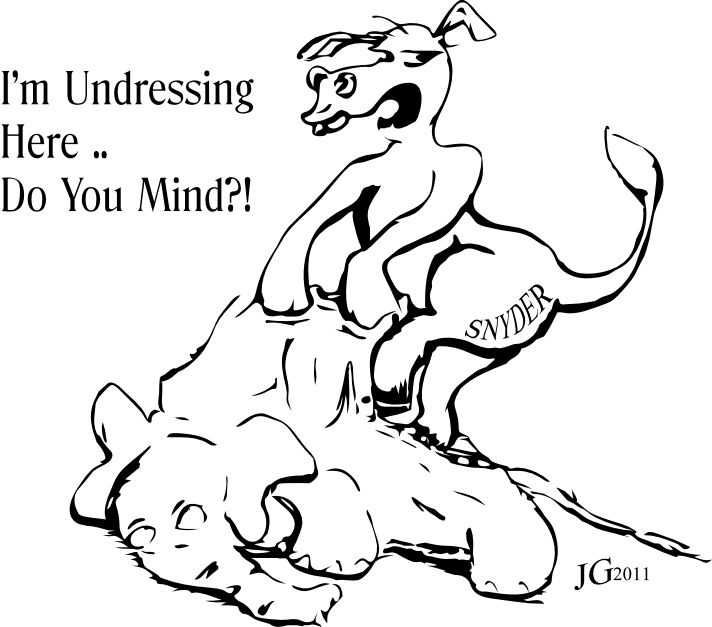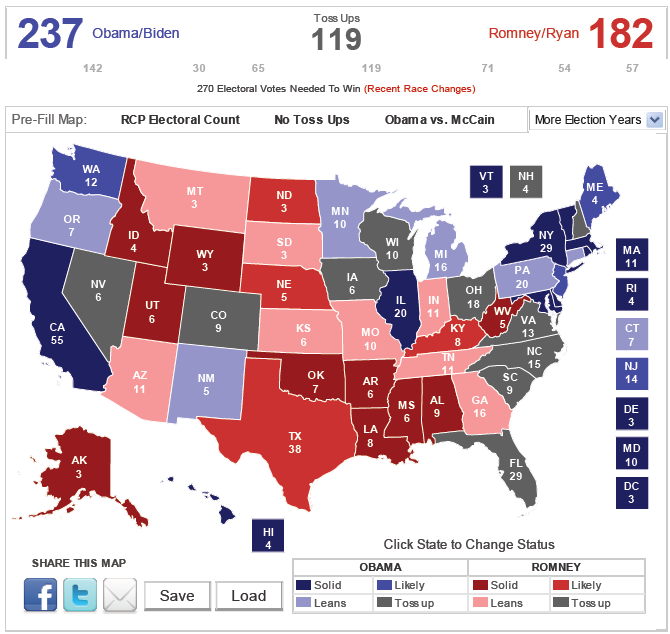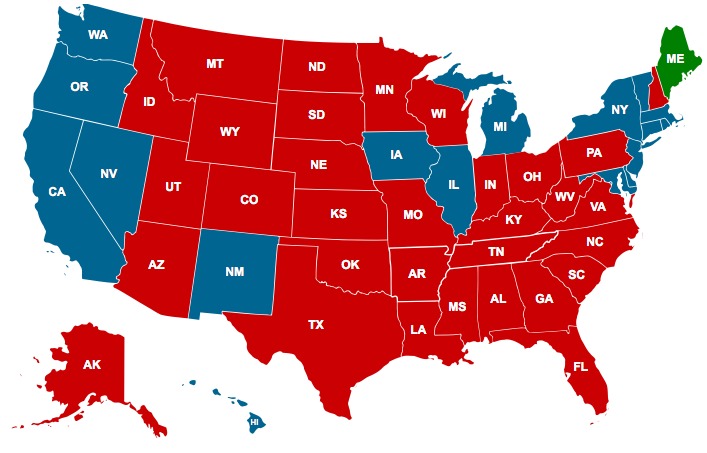
 |
NAVIGATION
|
NEWS TIPS!RightMichigan.com

Who are the NERD fund donors Mr Snyder?Tweets about "#RightMi, -YoungLibertyMI, -dennislennox,"

 |
Is 2012 Already In The "R" Column?By Kevin Rex Heine, Section News
Of the 56 quadrennial presidential elections to date in the United States, only twice has the electoral winner failed to carry his home state. (Woodrow Wilson lost New Jersey in his 1916 re-election bid and James K. Polk lost Tennessee in the 1844 election.) More common, occurring nine times thus far, is a president failing to carry his native state and still win the election, such as George W. Bush losing Connecticut or Abraham Lincoln losing Kentucky. (President Polk has the dubious distinction of being on both lists, as he also failed to carry his native state of North Carolina in 1844.)
However, if we are to believe a report out of the University of Colorado from last month, W. Mitt Romney may just be joining that club this year.
And for the record, I absolutely agree with Laura Ingraham. There is not one good reason that the Republican Party shouldn't walk away with the White House, at least a seven-seat pickup in the U. S. Senate, flipping at least four governorships (Montana, New Hampshire, North Carolina, Washington, and possibly also West Virginia), and expanded majorities in the U. S. House, state legislatures, and even county boards of commissioners. Yet, to hear the various polls and mainstream media outlets tell it, BHO has between a 75% and 92% of re-election, and you can kiss flipping the Senate good bye right now. Eleven "battleground" states totaling 146 electoral votes, seventeen vulnerable Senate seats, five vulnerable democrat governors, and somehow this is already a done deal for Obama, Reid, and O'Malley.
I don't think so. See, I was doing a bit of comparing of the various Electoral College poll aggregators this week (FiveThirtyEight, Election Projection, ElectoralVote, 270 To Win, and RealClearPolitics), and I'd noticed that we may have a bit more than just the "battleground" states in play. Setting each of the states into its shakiest position as of this morning gives us this layout:
Probably safe Democrat (172 EV):
 No real surprise, the "tipping point state" (the probability that any given state provides the decisive 270th electoral vote, putting the candidate over the top) is currently projected to be either Florida or Ohio (depending on which aggregator you believe), though that could change at any time during the next 46 days. (Colorado, Iowa, Michigan, Nevada, New Hampshire, Pennsylvania, Virginia, and Wisconsin have also been suggested as potential tipping point states, along with five or six others.) Six and a half weeks out, and we still have 24 states worth a total of 255 EV "in play on paper" in the Electoral College. I suppose the skeptical among us can be forgiven for questioning the alleged inevitability of Barry's second term. Interestingly enough, a report from Breitbart yesterday points out that most media reports predicting an Obama win are not only oversampling Democrat opinion, they're also "wildly inflating Democrat turnout." That means, at least in my head, that the liberal media elites spinning this election as already won by Obama, Reid, and O'Malley aren't doing a whole lot more than just that . . . spinning a story. But what I find really fascinating is a report released from the University of Colorado just over four weeks ago that didn't get much more than 72 hours of media coverage. Apparently, political science professors Kenneth Bickers of CU-Boulder and Michael Berry of CU-Denver have developed an Electoral College prediction model that has been right every single time, and they've been using it since 1980. This model has correctly predicted the winner of the popular vote and electoral vote every single time for eight presidential elections straight, including correctly predicting the PV-EV disconnect in 2000. It's been off by an average of 21.3 electoral votes and 5.5 states, but has never once been wrong as to the ultimate outcome of the election. Now, to be fair, both professors admit that their current projection relies on economic data from June, and that a follow-up report, due to be published this month in PS: Political Science & Politics (a peer-reviewed journal of the American Political Science Association), will use more current information and update their projections accordingly. They also admit that, in states where the polling is providing a bona fide toss-up scenario, anything could cause that state to break in an unpredictable direction. But make no mistake; the CU model is based heavily on state-by-state "big picture" economic issues, treating popular vote polling strictly as a secondary consideration. This lends a whole new level of meaning to James Carville's Clinton campaign talking point, "It's the economy, stupid." So, even though the Washington Times, the Denver Post, the Huffington Post, the JD Journal, the London Daily Mail, the Mercury News, the Blaze, the Daily Caller, and the Spokesman-Review all carried the story within 72 hours of the University of Colorado article, it didn't seem to be that big of a deal to the major news outlets. Maybe it's because they didn't like the selection of headlines they'd have to choose from:
The kicker, as well as the historically amusing detail, lies in how the eleven battleground states are expected to break, three for Obama and eight for Romney:
That means, assuming the CU model holds, that come the Monday following the second Wednesday in December of this year, President Polk may no longer be the only president to lose both his native state and his home state and still win the presidency. Of course, there's also that average error factor (5.5 states for a net shift of 21.3 electoral votes) that I mentioned earlier. Now, the way that the "average error" works is that you take any five or six states, and flip them in such a way as to produce a net shift of 21 electoral votes. They don't all have to go one way, and historically the error states won't all break the same way. You can select from the 11 battleground states, the 10 toss-up states (and there's a 9-state overlap between the two), or just for fun mess around with all 24 "in play on paper" states to see how various combinations of that error factor might play out. We could even make a game out of it here on RM, using the CU model as our baseline and seeing who can accurately predict which states will shift how. Either way, the University of Colorado model currently has Michigan's Native Son finishing up with somewhere between 299 and 341 electoral votes, which is a Romney win no matter how you slice it. I'm going to be keeping my eyes open for that update this month, because I really want to see how much the economic non-recovery over the summer has created an unsolvable problem for the Obama re-election crew.

Is 2012 Already In The "R" Column? | 5 comments (5 topical, 0 hidden)
Is 2012 Already In The "R" Column? | 5 comments (5 topical, 0 hidden)
|
Related Links+ flipping at least four governorships+ battlegrou nd + seventeen vulnerable Senate seats + FiveThirty Eight + Election Projection + ElectoralV ote + 270 To Win + RealClearP olitics + tipping point state + depending on which aggregator you believe + next 46 days + report from Breitbart yesterday + It's the economy, stupid + Analysis of election factors points to Romney win, University of Colorado study says + Economic model correctly picks last 8 presidents, predicts Romney win + CU forecasters predict a Romney presidency + Electoral College Prediction Model Points To Mitt Romney Win In 2012 + University of Colorado Electoral College Model Predicts 2012 Election Winner + Electoral College computer model that's correctly predicted presidential elections since 1980 shows big WIN for Romney + Romney will win election, state-by-state study predicts + Electoral College Model Predicts Romney Will Win Big In 2012 + University of Colorado prediction model points to big Romney win + Electoral College prediction model points to Romney win + in play on paper + Also by Kevin Rex Heine |